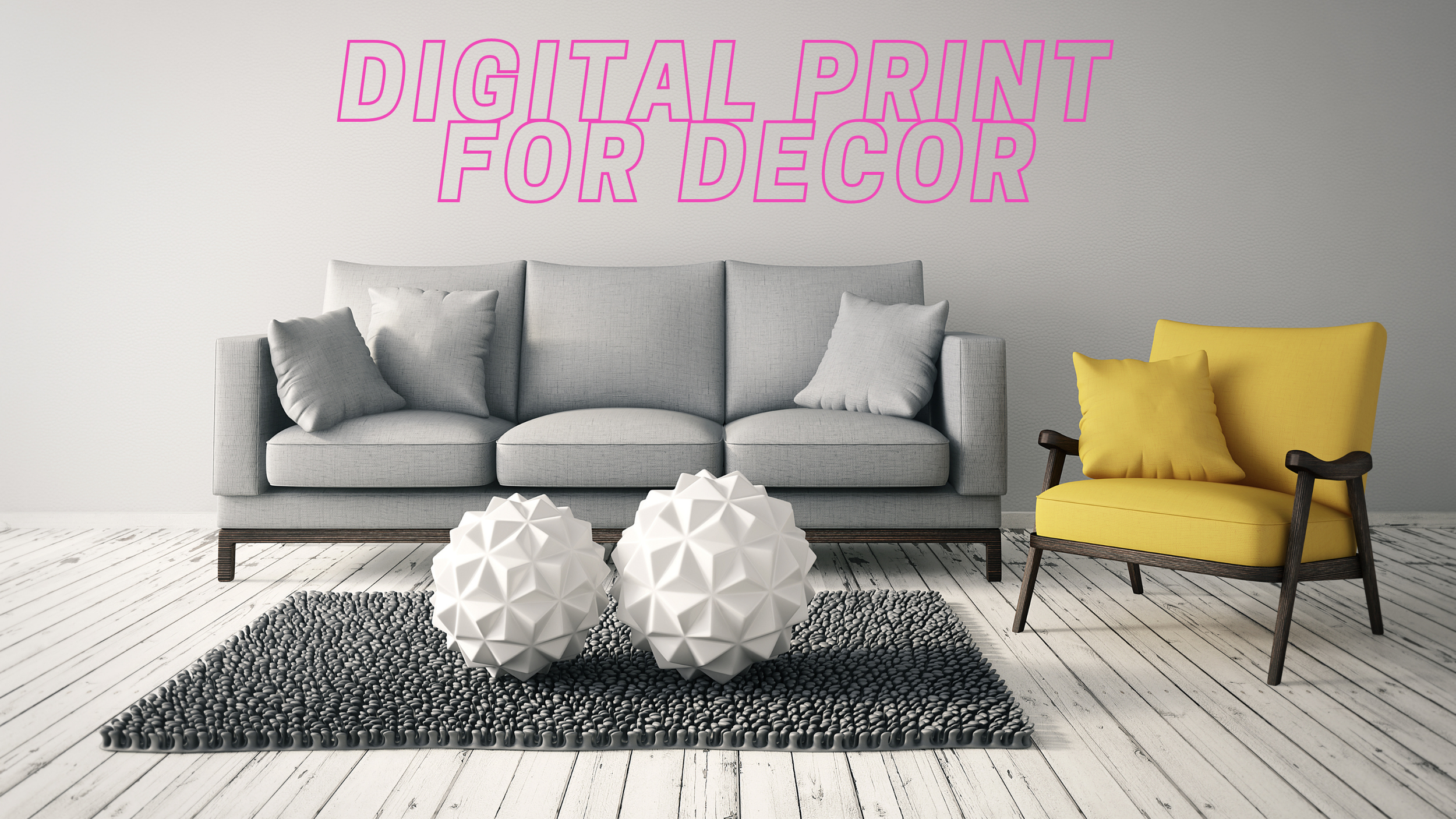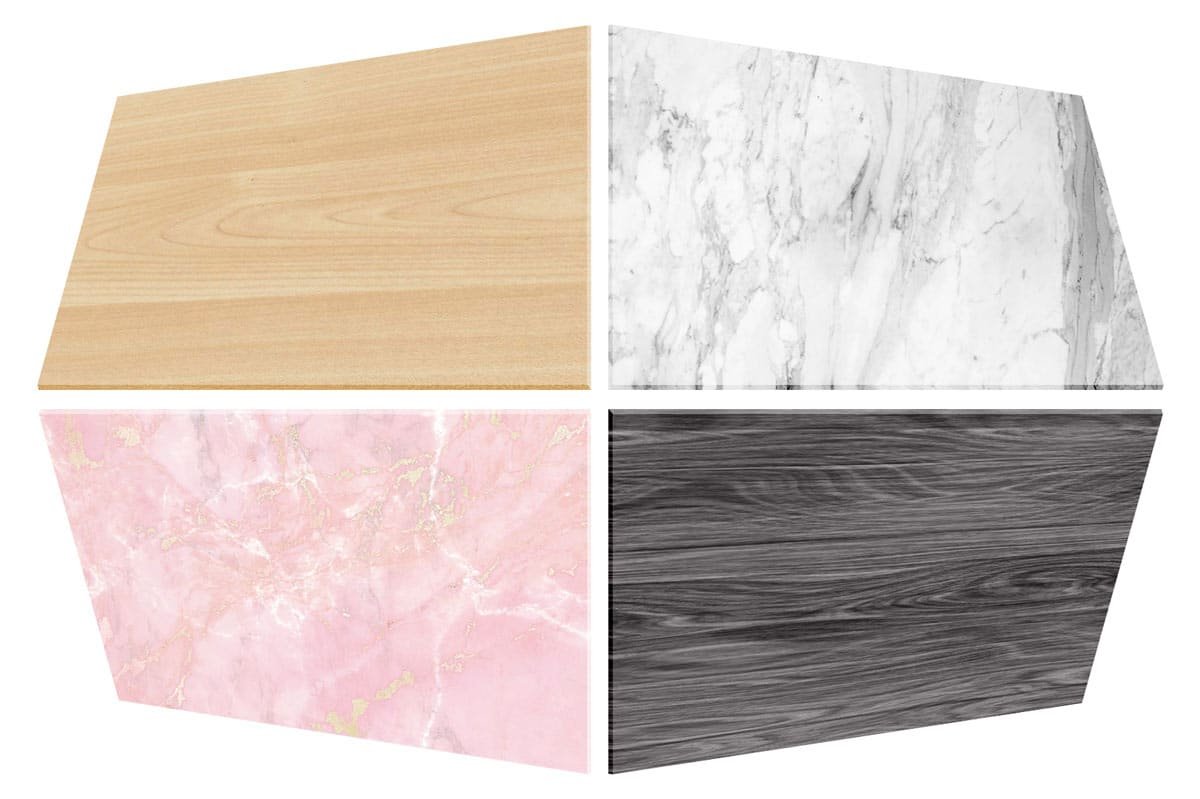Inkjet Opportunities in the Décor Market
Look around – whether you’re at home, at your place of work, or elsewhere out in the world, print is everywhere. With interior décor one of the largest and fastest growing markets in digital printing, it’s set to become an even more significant part of our lives. Kris Walewijns, Global Strategy & Business Development Manager at Canon Production Printing citing Smithers Pira’s report ‘The Future of Printed Signage in an Electronic World to 2024’, explains: “In 2024, the global printed signage market within interior décor will, it is speculated, be worth 54 billion dollars. This has long since established the interior décor market as a very lucrative investment with sustainable growth for print service providers.”
It’s not difficult to see why the décor market is perfectly placed for a digital print boom. In a market still largely dominated by gravure, the flexibility offered by digital opens up a whole new world of design possibilities. Phil Jackman, Global Product Manager – Digital, Sun Chemical says: “Unlike gravure printing, where the repeat length for a pattern is limited to the circumference of the print cylinder, digital printing has no restriction on the image. Repeat length detail of shading of colour meaning designers and consumers have much greater choice in what can be produced.”
The opportunity for fully customisable décor is highly appealing not just to businesses and brands, but also to consumers, who are embracing personalised designs that can help them put their own unique stamp on their home, and digital print for wallpaper, flooring, and soft furnishings offer huge opportunities for print businesses to deliver interiors that meet the individual desires of end consumers. “During the pandemic, there has been a 185% rise in demand for personalised designs in the everyday consumer’s home,” says Canon’s Walewijns. “Digital print means consumers can now order tailored products based on criteria such as how long they want them to last, what surface they are applying it to, and whether they want to install it themselves.”
Marc Graindourze, Business Development Manager Industrial Inks, Agfa, explains that although this largely analogue segment was experiencing a shift to digital pre-COVID, he agrees that the pandemic has played a role in accelerating adoption: “People want to be able to make their home how they like it with a good choice of designs, or businesses want their logos included, or perhaps you would like special furniture panels, this is all much easier to achieve with inkjet thanks to one-off or very short runs, which is impossible with gravure. That demand is of course increased by the pandemic because people couldn’t travel, and many spent that money for decorating or refurbishing their house.”
Agfa Altamira Panels
Reductions in inventory and waste can mean substantial savings from both cost and environmental impact standpoints. The capacity to print on-demand and the necessity for warehousing capabilities is removed, a game-changer for décor producers who have traditionally needed a large amount of additional space within their factory for this. On waste reduction, Sun Chemical’s Jackman adds: “With traditional print methods there is typically a large amount of wasted ink (due to the need for a print cylinder to be full for the whole print run) and potential for producing printed substrate that may not be sold. Digital print enables a flexible, on-demand production where you print what you need and only use ink when required reducing the need for cleaning of cylinders, disposal of waste ink and solvent and discarded paper.”
Rachel Li, Segment Marketing Manager, Fujifilm Ink Solutions Group, adds: “Digital largely reduces the material stock. We now talk a lot about sustainability and how to save energy as well as save costs, which is possible with digital compared to analogue.” Simon Edwards, Business Manager for Software Solutions, Global Inkjet Systems, adds: “Inkjet printing offers numerous competitive advantages over conventional décor printing methods such as pad printing, screen or offset printing, including creating greater design flexibility and complexity, and reducing time to market and bulk stock requirements.”
Maximising Interior Opportunities in Inkjet
While the inkjet décor space is a booming market, it’s certainly competitive, and there is much to research and consider before jumping in with both feet. A solution for décor, as with most inkjet applications, needs to be considered holistically, with the hardware, software, and ink all considered early on in the process. Jackman of Sun Chemical says: “For the successful adoption of digital printing, it is important to match the technology to the market and the substrate. Wallpaper can vary from embossed vinyl to non-woven to paper or mylar. Some options are self-adhesive for easy application and widths are typically 53cm for a standard roll and 106cm for a wide roll (often used in commercial buildings and hotels for example). With these considerations in mind, it is important to match the hardware, software and critically the ink to the application to ensure the right performance.
“The system will define the print speed and resolution with software managing colour matching (which is a stringent requirement in wallpaper) and nozzle correction during print to mask any impact of a missing nozzle during a production run. The ink needs to meet the specifications of the printer and process to ensure reliability in single-pass printing, the ability to be dried in a realistic timeframe aligned with production speed and system footprint and meet the overall colour and application requirements.”
Fujifilm’s Rachel Li echoes the importance of the ink, and of working closely with the ink manufacturer to ensure the formulation fits the specification. “As an ink company, when we work with our customers we have a very long list to check to make sure we understand exactly what they required. Then we can put together a project specification to develop inks that are specific for the system, for the machine for the printhead, for the speed, and that also fit with pre- and post- printing processes.”
Software is a crucial part of the process that can sometimes be overlooked, but those wishing to find success in the competitive décor market would be remiss not to consider the importance of software as a key defence against print quality issues. Simon Edwards of Global Inkjet Systems says: “Industrial digital printing presses often include large arrays of high resolution printheads. Despite the tight manufacturing tolerances, there is still variation in the performance of each nozzle within a printhead, as well as from printhead-to-printhead, which often leads to image defects in the final print. As a result, it is highly likely that there will be printheads with missing nozzles, as well as variation in the nozzle performance within a printhead and from one printhead to the next. For many digital printing applications, it is critical to use software compensation to adjust for these variations and hence reduce the visibility of these nozzle-to-nozzle and printhead-to-printhead variations in the printed output.
“The application of intelligent software systems is becoming one of the most significant differentiators between average and top-quality print performance. In particular, software that is highly optimised for data rate performance, ‘hardware aware,’ and able to compensate for some of the shortcomings of printing systems.”
On the importance of printheads, we should highlight how key haptics are to some aspects of interiors – people will be up close to the print, engaging with and touching the products. Using technology and processes patented by Spanish company BARBERÁN, Jetmaster printers print decorative designs on different types of substrates with a very high resolution and at high speeds for decorative panels with a haptic, textured finish. The technology used in the SEIKO 508GS and RC1536 heads by its engineers greatly contributed to finding the perfect solution.
BARBERAN Jetmaster
Jet Setting in Décor
FuturePrint partners are already serving the décor space and helping their customers meet the demands of a range of applications. For Sun Chemical, the wallcoverings market is an ideal fit: “With our longstanding expertise in digital print chemistry and detailed knowledge of décor markets, Sun Chemical can work with partners to tune inks for markets and applications,” says Jackman. “Or range of Streamline AP aqueous inks are available for different industrial printheads and exhibit excellent print performance on a range of wallpaper substrates.”
DLEPlus Hymmenn Collection
Hymmen also has a strong offering, more specifically in flooring, recently seeing patents for digitally embossed panel surfaces with various gloss grades granted in the US and China. René Pankoke, Managing Partner of Hymmen, comments: “Historically, Hymmen has maintained a strong IP position and the granting of these two new patents reinforces that even further. Digital printing continues to ramp-up as it will play a crucial role in the future of modular flooring. These new technologies offer manufacturers unlimited design and embossing-in-register flexibility on a wide range of materials.”
As demand grows and more businesses seek new opportunities to expand into décor, there are challenges to contend with as well. Canon aims to help manage these challenges, creating the UVgel Wallpaper Factory. Kris Walewijns says: “It’s a seamless, fully automated end-to-end solution featuring the Colorado 1650 in conjunction with the right finishing products to create a modular, scalable production line to fit the high volume production needs.
“At the heart is Canon’s completely odourless UVgel technology, enabling perfect quality and a velvety matt finish which the interior décor market likes so much, and at the same time also guaranteeing a perfect consistency in colour as well as dimensional stability, which are the typical pain points of digital décor printing.”
While Fujifilm had the ability to leverage its existing strong UV technology portfolio for décor applications, it has its sights set on water-based development. “Water-based is currently the big project we are working on,” explains Fujifilm’s Li. “In the future we want to use our technology capabilities in aqueous and UV, so we can provide multiple solutions for multiple applications in the decor market.”
Agfa’s Graindourze also explains that water-based inks are key to laminate flooring applications, printing on absorptive décor paper, jetting the inks and then impregnate with a melamine resin prior to heat pressing. “The water-based ink is just very compatible with décor paper, allowing you to print all kinds of designs with a low ink amount or high ink amount. UV ink would be fairly difficult in that process.” Agfa’s Altamira Design PID inkjet ink set is optimised for printed interior decoration such as furniture edge bands, profiles, panels, and other interior elements, fitting existing production processes as a replacement technology for traditional gravure.
On the software side, GIS’ solutions help businesses manage print quality, a crucial component to a market like décor. “GIS has introduced Atlas IQ Tools, a range of image quality tools to provide a superior level of image management and compensation for inkjet printheads,” comments Simon Edwards, who has been instrumental in the development of the Atlas Software Suite and the ongoing development of advanced quality enhancement features. “Without these tools, print artifacts such as grainy images, discontinuities between printheads and density variation can become evident in the printed image to such an extent that the print result is unsaleable.”
GIS Atlas IQ
While analogue remains dominant in printed interior décor, the benefits of inkjet are manifold, including better design and colour freedom, waste, inventory and cost reductions, customisation and personalisation flexibility, faster time to market and more. For those that do their due diligence and forge the right partnerships, there are many opportunities to be found in this growth area.





